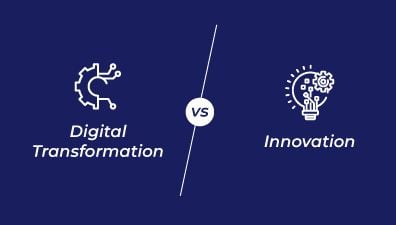In today’s rapidly evolving business landscape, the importance of digital transformation cannot be overstated. As technology continues to reshape industries and consumer expectations, organizations must adapt or risk falling behind. Digital transformation is not merely an option, it has become a strategic imperative for businesses to thrive and remain competitive in the modern era. This journey of digital transformation involves a holistic reimagining of how businesses operate, connect with customers, and leverage technology to drive innovation and efficiency. In this exploration, we delve into the significance of successful digital transformation and uncover the key requirements that underpin its success.
Table of Contents
- 6 Key Requirements for Successful Digital Transformation
- Clear Vision and Strategy for Digital Transformation Success
- Strong Leadership and Cross-functional Collaboration
- Data-Driven Approach for Digital Transformation Success
- Agile and Adaptive Culture
- Customer-Centric Focus for Digital Transformation
- Continuous Monitoring and Iteration for Digital Transformation Success
- The Importance of Digital Transformation in the Modern Business Landscape
- Case Studies: Real-World Examples of Successful Digital Transformations
6 Key Requirements for Successful Digital Transformation
Clear Vision and Strategy for Digital Transformation Success
One of the primary digital transformation challenges is the high rate of adoption. It’s noteworthy that a staggering 90% of companies have initiated digital transformation efforts. However, the journey to achieving the expected benefits is far from straightforward. On average, only a third of the anticipated revenue benefits have materialized. This glaring gap between intentions and outcomes underscores the critical need for a well-defined vision and strategy.

To be able to have a clear vision and strategy while implementing digital transformation, companies need to ensure these digital transformation requirements:
- Defining the purpose and objectives of digital transformation: To overcome the challenges and ensure a successful transformation, organizations must articulate a clear purpose and set of objectives for their digital initiatives. This involves understanding why digital transformation is necessary, whether it’s to enhance customer experiences, optimize operations, or explore new revenue streams. Without a precise purpose, organizations risk wandering aimlessly in the digital landscape.
- Aligning the transformation strategy with overall business goals: A cohesive strategy is essential for aligning digital transformation efforts with broader business objectives. This alignment ensures that digital initiatives are not isolated endeavors but integral components of the organization’s overarching mission. Whether the goal is to increase profitability, expand market reach, or improve efficiency, the strategy should directly contribute to these aspirations.
- Creating a roadmap outlining milestones and timelines: Developing a roadmap is instrumental in guiding the digital transformation journey. It provides a structured approach by outlining specific milestones and timelines. This roadmap serves as a compass, helping organizations stay on course, track progress, and make necessary adjustments. It also helps manage expectations and ensures that transformation efforts remain focused and achievable.
Strong Leadership and Cross-functional Collaboration
Strong leadership and cross-functional collaboration are essential pillars for achieving successful digital transformation. In an era where– digital and technological advancements are reshaping industries, organizations must place significant emphasis on these aspects to navigate the complexities of their transformation journeys effectively.
The presence of strong leadership is one of the fundamental prerequisites for a successful digital transformation. Organizations need a dedicated transformation leader or team with the vision, expertise, and authority to drive change. This leader catalyzes the entire transformation effort, setting the direction, rallying the workforce, and ensuring that digital initiatives align with strategic objectives. Their role extends beyond merely overseeing the process; they inspire and motivate teams to embrace new technologies and adapt to evolving ways of working. A strong leader is also someone great at locating resources and budgeting. For digital transformation, this can be a huge problem, especially for small and medium companies with minimal resources. This is why companies should consider digital transformation agencies.

Digital transformation is inherently cross-functional. To harness its full potential, organizations must break down silos and foster collaboration among diverse departments, including IT, operations, marketing, and more. This collaboration ensures that the transformation efforts address the holistic needs of the business. For example, IT and marketing teams must work together seamlessly to enhance customer experiences through digital channels, while operations teams may need to streamline processes to accommodate technological changes. Effective collaboration not only accelerates the transformation but also leads to innovative solutions that drive business growth.
Communication is the linchpin of successful digital transformation. It is crucial to establish clear and transparent communication channels for sharing progress and addressing challenges. Regular updates, feedback mechanisms, and forums for sharing insights help keep all stakeholders informed and engaged. When teams across the organization are aware of the transformation’s status, challenges, and successes, they can better align their efforts and provide valuable input. Furthermore, open communication fosters a culture of adaptability, where teams are willing to embrace change and iterate on strategies as needed.
Data-Driven Approach for Digital Transformation Success
In the realm of digital transformation, a data-driven approach is paramount to overcoming the challenges associated with data in established companies. Data often poses frustrations, and a substantial portion of the effort involved in developing AI-based solutions, up to 70%, can be attributed to the intricate process of wrangling and harmonizing data. Scaling digital solutions becomes a formidable challenge unless data is thoughtfully organized for easy consumption and reuse. Achieving this is pivotal for constantly improving customer experiences and reducing operational costs. To address these challenges, organizations can focus on three critical areas.
The foundation of a data-driven approach lies in the systematic collection and analysis of relevant data. This data serves as the bedrock for informed decision-making across all facets of the organization. By harnessing data, organizations gain insights into customer behaviors, market trends, and operational efficiencies, empowering them to make strategic choices that drive growth and innovation. Timely access to data is also essential in a rapidly evolving digital landscape. Implementing tools for real-time data monitoring and insights enables organizations to stay agile and responsive. These tools provide up-to-the-minute information on key metrics, allowing teams to detect trends, identify opportunities, and address issues as they arise. Real-time data monitoring is particularly valuable in dynamic environments where swift decision-making is a competitive advantage. Finally, after collecting, companies can leverage data to optimize processes, personalize customer experiences, and innovate. Personalization, driven by data-driven insights, enhances customer experiences by tailoring products and services to individual preferences. Furthermore, data fuels innovation by providing the foundation for developing new products, services, and business models that cater to evolving market demands.

In addition to these areas, organizations can adopt several strategic moves to enhance their data-driven capabilities:
- Utilize reusable building blocks, specifically data products: Data products play a crucial role in effectively scaling AI and data-intensive applications. They enable organizations to deliver data-driven solutions up to 90% faster, at a 30% lower cost, while reducing the risks and governance burdens associated with data. These products provide readily accessible, high-quality data sets that can be used across the organization, facilitating data-driven decision-making.
- Install the data architecture plumbing: An effective data architecture serves as the backbone for data distribution within the organization. It accelerates the development of reusable and high-quality data products while ensuring data accessibility for various teams. Recent innovations, such as the data lake house, combine the capabilities of data lakes and data warehouses into an integrated platform, simplifying business intelligence and AI needs.
- Federated data governance: Managing data governance across an organization’s multifaceted landscape requires a federated model. In this model, a central function, often a data management office, establishes policies and standards, offering support and oversight. Simultaneously, individual business units and functions manage activities such as developing data products and creating data pipelines for consumption.
Agile and Adaptive Culture
An agile and adaptive culture is the linchpin of success in the ever-changing landscape of digital transformation. This culture empowers organizations to navigate the complexities of the digital age effectively and stay ahead of the curve.

Here are the key components of fostering an agile and adaptive culture:
- Promoting a culture of innovation, experimentation, and risk-taking: Innovation is at the heart of digital transformation. Organizations must encourage a culture where employees are not only allowed but actively encouraged to innovate. This involves creating an environment where new ideas are welcomed, experimentation is embraced, and calculated risks are seen as opportunities for growth. By promoting innovation, organizations can continually evolve their digital strategies and remain competitive.
- Embracing flexibility to adjust strategies based on evolving market trends: In the digital landscape, change is constant. To thrive, organizations must be flexible and adaptable. This means being willing to adjust strategies and pivot based on evolving market trends, customer feedback, and emerging technologies. An agile culture allows teams to respond swiftly to changes, ensuring that digital initiatives remain aligned with the dynamic needs of the business and its customers.
- Encouraging continuous learning and upskilling of employees: Digital transformation requires a skilled and knowledgeable workforce. Organizations should prioritize continuous learning and upskilling programs to equip employees with the latest digital competencies. This includes offering training in areas such as data analytics, artificial intelligence, and digital marketing. By investing in employee development, organizations not only enhance their digital capabilities but also foster a culture of continuous improvement.
Customer-Centric Focus for Digital Transformation
A customer-centric focus is the cornerstone of successful digital transformation. Organizations that prioritize understanding and satisfying customer needs are more likely to thrive in the digital era.

Here are the key components of maintaining a customer-centric focus:
- Understanding customer needs and pain points through data and feedback: Data and customer feedback are invaluable sources of insight. Organizations should invest in robust data analytics to gain a deep understanding of customer behavior, preferences, and pain points. By analyzing data and listening to customer feedback, companies can identify areas where digital solutions can make the most significant impact. This data-driven approach ensures that digital initiatives are aligned with genuine customer needs.
- Designing digital solutions that enhance customer experiences: The ultimate goal of digital transformation is to improve customer experiences. Organizations should prioritize designing digital solutions that simplify and enhance interactions with customers. User-centric design principles should guide the development of websites, apps, and digital services. The focus should be on creating intuitive, user-friendly interfaces that provide value and delight to customers.
- Implementing omnichannel strategies to provide seamless interactions: Customers expect seamless experiences across multiple channels, whether it’s a website, mobile app, social media, or in-person interactions. Implementing omnichannel strategies ensures that customers can engage with the organization consistently and conveniently across all touchpoints. This requires integrating systems and data to provide a unified view of the customer, enabling personalized and efficient interactions.
Continuous Monitoring and Iteration for Digital Transformation Success
Continuous monitoring and iteration are fundamental principles of successful digital transformation. To ensure that digital initiatives remain effective and aligned with organizational goals, it’s crucial to implement a process of ongoing assessment and improvement.
Here are the key components of continuous monitoring and iteration:
- Regularly assessing progress against predefined KPIs: Key Performance Indicators (KPIs) serve as the yardstick for measuring the success of digital transformation initiatives. Organizations should establish clear KPIs at the outset of the transformation journey and regularly assess progress against these metrics. This involves tracking and analyzing data to determine whether the transformation efforts are achieving the desired outcomes. If KPIs are not being met, it may be necessary to adjust strategies or tactics.
- Gathering feedback from stakeholders and customers for improvements: Feedback is a valuable source of insights for optimization. Organizations should actively seek feedback from both internal stakeholders (employees) and external stakeholders (customers). This feedback can uncover pain points, challenges, and areas for improvement. Listening to the voices of those affected by the transformation allows organizations to make informed decisions and refine their digital solutions.
- Iterating the transformation strategy based on insights and lessons learned: Digital transformation is not a one-time event but an ongoing process. To stay relevant and effective, organizations must be willing to iterate and adapt their strategies based on insights and lessons learned along the way. This iterative approach allows for continuous improvement and ensures that the transformation remains aligned with changing business needs and market dynamics.
The Importance of Digital Transformation in the Modern Business Landscape
Digital transformation has become a paramount focus in the modern business landscape, and the numbers underscore its profound importance. According to the IDC Worldwide Semiannual Digital Transformation Guide, organizations worldwide are set to invest a staggering $2.3 trillion in technologies and services that enable digital transformation by 2023. This substantial investment demonstrates the commitment of businesses to leverage digital technologies to drive growth, innovation, and competitiveness.
Moreover, the digital transformation market is experiencing rapid growth, with an annual growth rate of 19.1%. From $521.5 billion in 2021, it is projected to reach $1.27 trillion by 2026, emphasizing the increasing recognition of digital transformation as a strategic imperative for organizations across various industries.
The World Economic Forum predicts that the potential value of digital transformation for society and industry could reach an astonishing $100 trillion by 2025. This figure reflects the transformative power of digital technologies in reshaping economies, industries, and the way we live and work.
The COVID-19 pandemic has played a significant role in accelerating digital transformation. A survey by Deloitte reveals that 60% of executives believe the pandemic expedited their digital initiatives. Furthermore, 62% of executives expect digital transformation to remain a top priority over the next two years. The pandemic highlighted the critical role of digitalization in business resilience and adaptability, making it a continued focus for organizations in the post-pandemic world.
Case Studies: Real-World Examples of Successful Digital Transformations
Abbott
As a part of Abbott Laboratories, a Fortune 500 healthcare company operating in over 160 countries, Abbott Vietnam has successfully implemented a digital transformation project with the assistance of Magenest. Their challenge was managing numerous distribution channels and partners efficiently while optimizing their sales processes and embracing digital transformation.
Magenest’s solution involved the development of an integrated Magento 2 eCommerce platform tailored to Abbott’s multi-brand business with a wide product range. This platform allowed for scalability, easy integration with chatbots, and automation of sales activities. Additionally, Magenest provided guidance and training for Abbott’s team to ensure seamless operation of the system.

To address the need for scalability and resource management, Magenest advised Abbott to use Amazon Web Services (AWS) for their eCommerce website, ensuring it could handle the substantial daily traffic and large data volumes. AWS provided a robust and reliable infrastructure for its digital operations.
The project also included the automation of sales and consultation processes, with the integration of a chatbot, store locator, and distribution management system. The chatbot streamlined product consultation, reducing the need for personnel involvement and improving customer information delivery. The store locator feature checked inventory at nearby retail locations and facilitated faster order processing. A separate management system for distribution partners enabled real-time inventory and purchasing information sharing.
As a result, Abbott Vietnam experienced improved user engagement and revenue growth, thanks to the simplified and automated sales and consultation processes facilitated by the chatbot. The eCommerce website expanded sales channels, reduced reliance on third-party platforms, and increased digital reach. Moreover, the scalable website is well-prepared to meet Abbott’s future growth requirements.
Kangaroo
Kangaroo Group, a prominent player in Vietnam’s consumer appliances market, successfully embraced digital transformation to adapt to the growing trend of online shopping. Recognizing the importance of expanding their online presence, Kangaroo Group partnered with Magenest to implement a comprehensive eCommerce system. Their primary challenge was reducing their reliance on physical stores and showrooms while providing a seamless and luxurious online shopping experience.

Magenest’s solution involved developing an eCommerce system on the Magento platform, enabling efficient product and order management. They integrated this system with Kangaroo’s existing Pentamic ERP system, ensuring real-time data synchronization and eliminating manual data entry. Additionally, Magenest integrated shipping services and payment gateways to enhance the shopping experience and implemented an Affiliate Program to boost sales through affiliates. The project also involved optimizing the website’s user interface and user experience, resulting in increased traffic, higher orders, and improved customer satisfaction. Kangaroo Group’s administrators were able to take full control of the new eCommerce system, highlighting its user-friendliness and effectiveness.
Conclusion
As we conclude our journey through the realm of digital transformation, one thing becomes abundantly clear: the ability to adapt, innovate, and evolve in the digital age is the lifeblood of modern businesses. The case studies of Abbott Laboratories and Kangaroo Group serve as beacons of inspiration, showcasing how organizations can leverage technology to optimize processes, enhance customer experiences, and drive growth.
As technology continues to advance and consumer expectations evolve, the imperative to embrace successful digital transformation remains unwavering. It is not a destination but an ongoing process, a commitment to staying at the forefront of innovation, and a promise to deliver value in a rapidly changing world. The organizations that heed this call will not only survive but thrive in the digital era, shaping the future of business with each step of their transformative journey.











